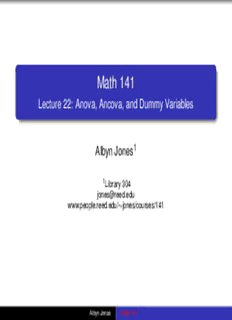
Math 141 - Lecture 22: Anova, Ancova, and Dummy Variables PDF
Preview Math 141 - Lecture 22: Anova, Ancova, and Dummy Variables
Math 141 Lecture 22: Anova, Ancova, and Dummy Variables Albyn Jones1 1Library304 [email protected] www.people.reed.edu/∼jones/courses/141 AlbynJones Math141 Multiple Regression All explanatory variables are numeric. Analysis of Variance All explanatory variables are categorical. Analysis of Covariance Some explanatory variables are numeric, and some are categorical. Reminder: The Linear Model Y = β +β U +β W +β X +(cid:15) i 0 u i w i x i i where the β’s are unknown constants, and the U’s, W’s and X’s are known constants. The linear model includes several special cases better known by other names: AlbynJones Math141 Analysis of Variance All explanatory variables are categorical. Analysis of Covariance Some explanatory variables are numeric, and some are categorical. Reminder: The Linear Model Y = β +β U +β W +β X +(cid:15) i 0 u i w i x i i where the β’s are unknown constants, and the U’s, W’s and X’s are known constants. The linear model includes several special cases better known by other names: Multiple Regression All explanatory variables are numeric. AlbynJones Math141 Analysis of Covariance Some explanatory variables are numeric, and some are categorical. Reminder: The Linear Model Y = β +β U +β W +β X +(cid:15) i 0 u i w i x i i where the β’s are unknown constants, and the U’s, W’s and X’s are known constants. The linear model includes several special cases better known by other names: Multiple Regression All explanatory variables are numeric. Analysis of Variance All explanatory variables are categorical. AlbynJones Math141 Reminder: The Linear Model Y = β +β U +β W +β X +(cid:15) i 0 u i w i x i i where the β’s are unknown constants, and the U’s, W’s and X’s are known constants. The linear model includes several special cases better known by other names: Multiple Regression All explanatory variables are numeric. Analysis of Variance All explanatory variables are categorical. Analysis of Covariance Some explanatory variables are numeric, and some are categorical. AlbynJones Math141 Coding categorical variables One special type of explanatory variable is the so-called dummy variable or indicator variable to mark membership in a category. Closely related are contrasts. The terminology you will see inRhelp files istreatment codingfor a dummy variable: categorical logical treatment contrast A vs B variable coding coding A FALSE 0 -1 B TRUE 1 1 AlbynJones Math141 Coding categorical variables: Example The Berkeley Longitudinal Study dataset includes a variable called sex, with values Male and Female. In this case, R will automatically code a dummy variable with values 1 for Male and 0 for Female (based on alphabetical order). AlbynJones Math141 Example: categorical explanatory variable > ht2.lm <- lm(ht2 ˜ sex, data=Berkeley) > summary(ht2.lm) Estimate Std. Error t value Pr(>|t|) (Intercept) 87.4656 0.5842 149.718 <2e-16 sexMale 0.9344 0.8725 1.071 0.289 Residual standard error: 3.305 on 56 df > with(Berkeley, tapply(ht2,sex,mean)) Female Male 87.46563 88.40000 The summary() function reports the treatment coding by combining the name of the variable (sex) with the category coded as 1: sexMale. The mean height for females is the intercept, for males it is the sum 87.4656+0.9344. AlbynJones Math141 Compare: two sample t-test > with(Berkeley,t.test(ht2˜sex,var.equal=TRUE)) Two Sample t-test data: ht2 by sex t = -1.0709, df = 56, p-value = 0.2888 alternative hypothesis: true difference in means is not equal to 0 95 percent confidence interval: -2.6822985 0.8135485 sample estimates: mean in group Female mean in group Male 87.46563 88.40000 AlbynJones Math141 Anova Anova is just another linear model! (Assuming it is a fixed effects model. For random effects or a mixed model don’t use least squares!) AlbynJones Math141
Description: